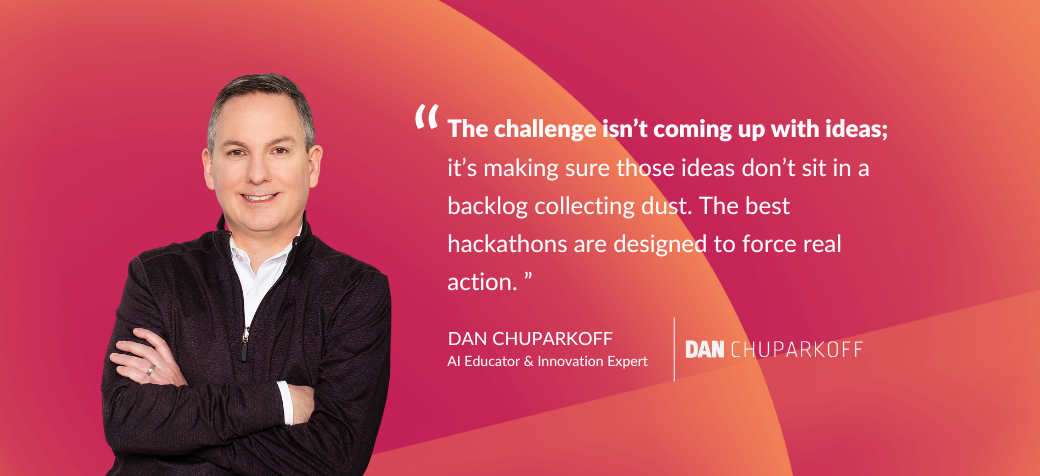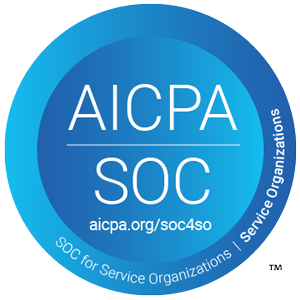Former Google, Atlassian, and McKinsey leader shares his perspective on fostering innovation, overcoming organizational blockers, and the role of AI in the future of high-performing teams.
Innovation doesn’t happen in a vacuum — it thrives in environments that encourage experimentation, rapid iteration, and real-world feedback. Few people understand this better than Dan Chuparkoff, a product management veteran who has spent over 30 years leading teams at some of the world’s most innovative companies, including Google, Atlassian, and McKinsey & Company. Today, as a keynote speaker and innovation consultant, Dan helps organizations navigate the evolving landscape of AI, remote collaboration, and the future of high-performing teams.
We sat down with Dan to discuss what separates high performers from the rest, how AI is reshaping the innovation process, and why hackathons are a game changer for companies that want to turn ideas into impact.
Key takeaways
- Structure hackathons around execution, not just ideation. Ensure that hackathons focus on building and shipping real prototypes that can be tested and refined.
- Test ideas in the real world, not just in meetings. Move beyond committee-driven idea selection and focus on gathering customer feedback as early as possible.
- Start with the smallest, most actionable version of your idea. Prioritize small, fast experiments over large, complex plans to accelerate innovation.
- Create a dedicated space for safe experimentation. Encourage employees to explore new ideas in a controlled, low-risk environment before committing resources.
- Use AI as a brainstorming partner, but trust human judgment for decision-making. Leverage AI to generate ideas, but rely on human experience and strategic priorities to decide which ones to pursue.
Structure Hackathons Around Execution, Not Just Ideation
Many organizations host hackathons but struggle to turn the resulting ideas into real products. They’re often treated as brainstorming events rather than platforms for meaningful innovation. While creativity and idea generation are crucial, hackathons should be designed to drive actual execution. Dan’s experience at Atlassian offers a valuable lesson into how hackathons should be approached.
“At Atlassian, we had ‘Ship It Days,’ which was different from the typical hackathon. The only way for an idea to count was if it got shipped — it had to be deployed and functional by the end of the event. A lot of companies assume they have an ideation problem, but in reality, they have an execution problem. The challenge isn’t coming up with ideas; it’s making sure those ideas don’t just sit in a backlog collecting dust. The best hackathons are designed to force real action.”
By shifting the focus from brainstorming to building, hackathons become powerful tools for driving measurable impact. Instead of merely celebrating creativity, organizations should integrate hackathons into their long-term innovation strategy. This means structuring hackathons in a way that ideas are not only generated but also validated, tested, and refined. When executed effectively, hackathons empower employees, fuel innovation pipelines, and drive meaningful business outcomes.
Test Ideas in the Real World, Not Just in Meetings
Many organizations fall into the trap of spending too much time debating and analyzing ideas rather than acting on them. Companies that succeed in innovation prioritize rapid experimentation, allowing real customer responses to dictate direction rather than internal debates. This approach helps avoid bias, ensures a more agile strategy, and allows for faster adaptation to changing customer needs. Many organizations rely on internal committees to vote on ideas, but Dan believes that’s a flawed approach.
“The companies that really do it well are the ones that get the little seeds of ideas into the market as soon as possible and start paying close attention to customer reactions. It’s not about debating which ideas seem best in a boardroom — it’s about putting something in front of real users and letting their responses shape the direction. Customers don’t always articulate exactly what they want, but their behavior tells you everything. Capturing data, identifying early excitement, and iterating based on real-world use — that’s what separates successful companies from those stuck in endless planning cycles.”
Instead of relying on opinions, the most innovative companies use customer feedback to validate ideas. They shift from a mindset of perfection to one of continuous improvement. By engaging real users as co-creators in the innovation process, companies build products and solutions that are more aligned with market needs.
Start With the Smallest, Most Actionable Version of Your Idea
A common misconception about innovation is that big ideas need big launches. Many companies hesitate to take action because they believe their ideas need to be fully formed before going to market. This mindset often leads to prolonged development cycles, unnecessary complexity, and missed opportunities.
Instead, successful teams focus on what Dan calls ‘finding the smallest, most actionable version’ of an idea. This approach reduces risk, accelerates learning, and increases the likelihood of success. By breaking down a big vision into smaller, testable components, teams can rapidly validate assumptions and iterate based on real-world feedback. This method also ensures that resources are spent efficiently, focusing only on what truly resonates with customers rather than what seems good in theory. Dan argues that truly effective teams focus on finding the simplest version of an idea to test first.
“People often get caught up in making something perfect before they share it, but that’s the wrong approach. The only thing that really matters is getting something tangible in front of customers as quickly as possible. The best teams are the ones that understand how to strip an idea down to its core — what’s the smallest, simplest thing we can test right now? If you wait until you’ve built everything, you’ve wasted valuable time. The key is to release, gather real-world data, and iterate. That’s where real innovation happens.”
This philosophy is deeply rooted in agile principles, but many teams lose sight of its essence. Instead of embracing agility as a means of fast learning through iteration, they become bogged down by overly rigid frameworks, excessive documentation, and unnecessary bureaucratic processes. True agility isn’t about following a prescribed set of rituals, it’s about learning as quickly as possible through small, incremental experiments. Successful innovators create feedback loops where each small test informs the next step, leading to faster adaptation and a better end product.
Create a Dedicated Space for Safe Experimentation
One of the biggest blockers to innovation is the lack of a safe space. Many organizations, particularly those in highly regulated industries, are reluctant to take risks. True innovation requires a balance, allowing room for safe failure while maintaining strategic oversight. Companies that encourage controlled experimentation benefit from rapid learning cycles, where employees can test bold ideas in a structured but low-risk environment.
Creating a culture where experimentation is encouraged, rather than penalized, is key to long-term adaptability and success. Dan believes that organizations must be intentional about building ‘sandboxes’: Dedicated spaces for teams to explore new ideas, refine emerging technologies, and iterate without the fear of repercussions.
“The most innovative companies foster a culture of experimentation. Whether it’s AI, automation, or any other emerging technology, teams need the ability to play, iterate, and experiment without immediate high stakes. If a company’s first exposure to a new technology happens only after it’s already widely adopted, they’re already behind. The best organizations give their people the space to explore — whether that means personal projects, dedicated R&D time, or internal hackathons — so that when the time comes to make a strategic decision, they’re prepared.”
Encouraging employees to test new tools and approaches in a low-risk environment accelerates learning and helps organizations adapt faster. Companies can implement experimentation frameworks, such as innovation labs, pilot programs, or cross-functional ideation sessions, to ensure that new ideas don’t just sit in a backlog but get actively tested. Organizations that cultivate this mindset gain a significant competitive advantage, as their teams develop a deep familiarity with emerging trends before they become industry standards.
Use AI as a Brainstorming Partner, But Trust Human Judgment for Decision-Making
AI has made it easier than ever to generate ideas, but Dan warns against treating it as an automatic decision-maker. While AI can quickly produce thousands of suggestions, its limitations lie in its lack of human intuition, emotional intelligence, and strategic foresight. The real power of AI lies in its ability to augment human creativity by generating diverse perspectives, helping teams break through mental roadblocks and streamline ideation. Organizations that learn to balance AI’s speed with human discernment will find themselves making better, more informed decisions.
“AI is an incredible brainstorming assistant, but it doesn’t have the context or judgment to determine what’s actually valuable. If you need 150 new ideas, AI can give them to you instantly, but it won’t necessarily tell you which ones to act on. That’s where human judgment comes in. The best approach is to use AI to help with ideation — pulling from a wider range of possibilities than we might naturally consider — but then have people apply their knowledge, intuition, and experience to decide which ideas should move forward.”
The key is to use AI to enhance human creativity, not replace it. Teams should implement structured decision-making frameworks that incorporate AI-generated insights while ensuring that human experts validate and refine the final selection. Successful integration of AI requires organizations to establish clear guidelines for how AI-driven ideas are evaluated, tested, and refined. Companies that adopt this hybrid model of combining AI’s computational power with human creativity and strategic thinking will stay ahead of the competition and create more innovative, impactful, and sustainable solutions.
Turning Ideas Into Impact
Dan Chuparkoff’s insights reinforce the importance of real-world testing, iterative development, and creating a culture of experimentation. At BrightIdea, we help organizations put these principles into action. Our innovation management platform provides teams the tools to capture ideas, run experiments, and scale their best solutions. Whether you’re looking to optimize your ideation process or drive execution with hackathons, we can help you turn your best ideas into measurable impact. Contact us today to learn more.
Want to hear more from Dan? Follow him on LinkedIn and keep an eye out for his upcoming book, The Innovation Machine, coming fall 2025.


